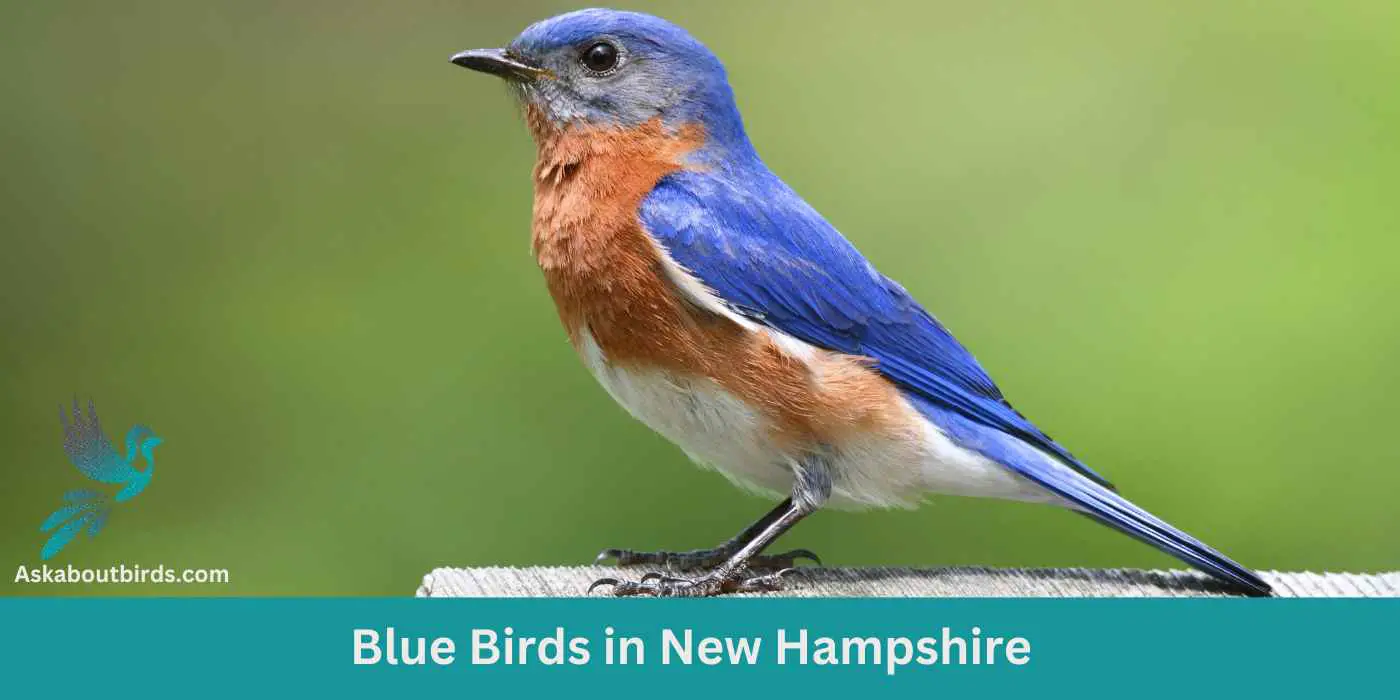Welcome to the picturesque state of New Hampshire, a haven for birdwatchers and nature enthusiasts alike. This guide is your ticket to exploring the vibrant world of blue birds in New Hampshire, featuring a curated selection of the most breathtaking species found in the region. Alongside our free photo guide, you’ll gain intimate knowledge of their habitats, behaviors, and the best spots to observe them in their natural glory.
Whether you’re a seasoned birdwatcher or a curious beginner, embark on a journey through the lush landscapes of New Hampshire and get acquainted with its beautiful blue-feathered inhabitants.
Blue Birds Found In New Hampshire
New Hampshire’s diverse geography is a key reason for its rich bird diversity. The state is home to a variety of habitats, from the White Mountains to the Lakes Region and the Seacoast. These different environments provide suitable nesting and feeding grounds for a wide array of bird species.
New Hampshire lies on the Atlantic Flyway, a major migration route for many bird species, which contributes to the diverse range of birds seen throughout the year.
Eastern Bluebird
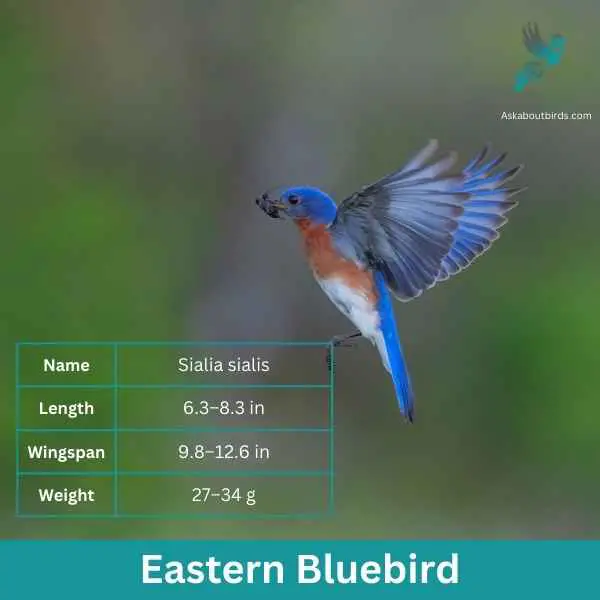
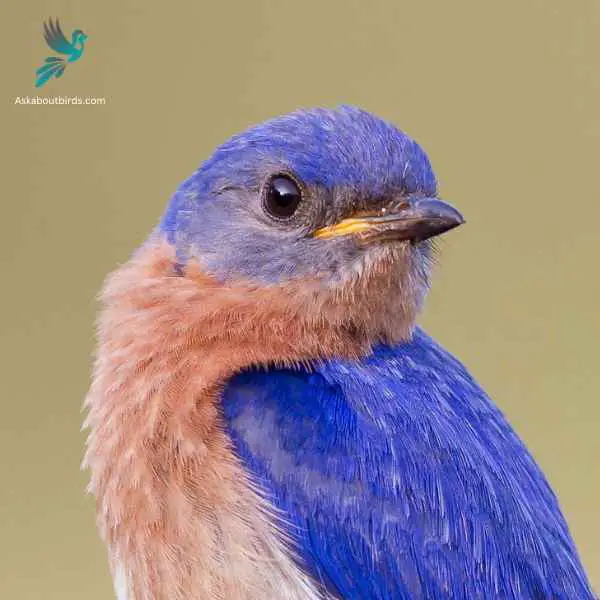
| Feature | Measurement |
|---|---|
| Scientific Name | Sialia sialis |
| Length | 6.3–8.3 in |
| Wingspan | 9.8–12.6 in |
| Weight | 27–34 g |
The Eastern Bluebird (Sialia sialis) is a small thrush found in open woodlands, farmlands, and orchards, and is recognized for its vibrant blue and red coloration. Male Eastern Bluebirds are dazzling with bright blue upperparts and a rusty or brick-red throat and breast, while females, though less colorful, still offer a similar pattern. The bird is native to North America and is commonly seen east of the Rockies, from Canada to the Gulf States and southeastern Arizona to Nicaragua.
Eastern Bluebirds feed on insects, wild fruit and berries. They have a gentle nature and are often seen perched alone or in small groups in the open, scanning the ground for prey. They are cavity nesters and will use old woodpecker holes or birdhouses if they are the right size.
Mountain Bluebird
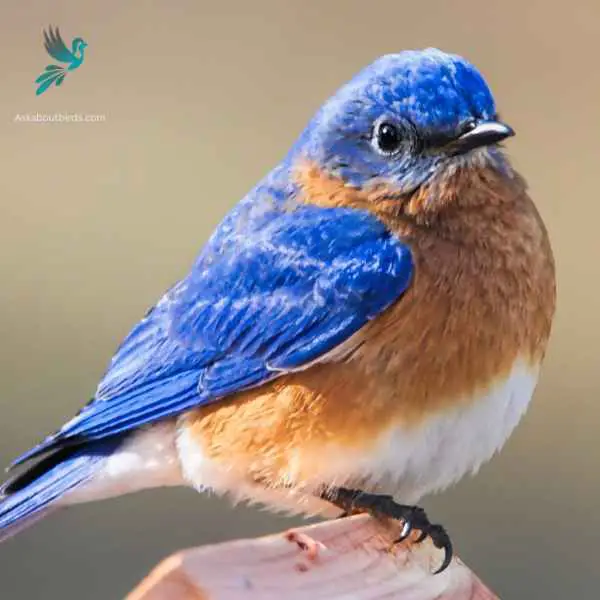
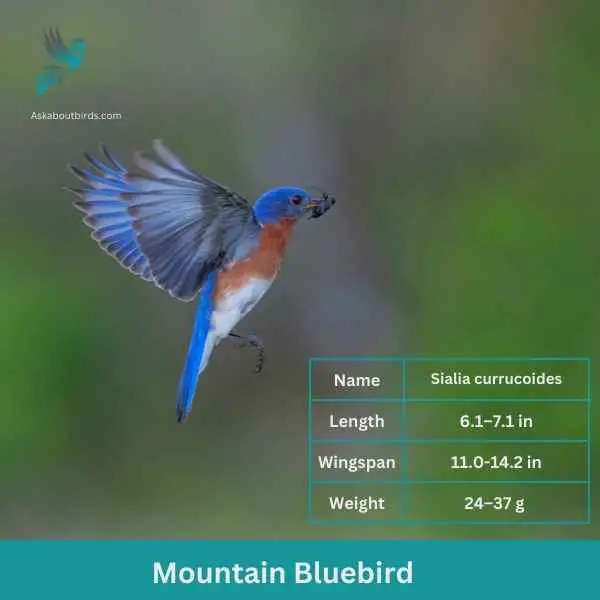
| Feature | Measurement |
|---|---|
| Scientific Name | Sialia currucoides |
| Length | 6.1–7.1 in |
| Wingspan | 11.0-14.2 in |
| Weight | 24–37 g |
The Mountain Bluebird is a small bird found in open grasslands and rocky mountains of North America. It is known for its stunning blue plumage, which is particularly vibrant in males. Females, on the other hand, have a more subdued blue coloration with hints of gray. These birds have slender bodies and a slightly curved bill, adapted for catching insects on the wing.
Mountain Bluebirds are insectivores, feeding primarily on insects such as beetles, grasshoppers, and spiders. They are skilled aerial hunters, capable of capturing their prey in mid-flight. During breeding season, these birds build their nests in tree cavities or man-made nest boxes, where females lay a clutch of eggs. The male bluebird actively participates in nest-building and provides food for the female during incubation.
Indigo Bunting


| Feature | Measurement |
|---|---|
| Scientific Name | Passerina cyanea |
| Length | 4.5–5.1 in |
| Wingspan | 7.1–9.1 in |
| Weight | 11.2–21.4 g |
The Indigo Bunting is a strikingly vibrant songbird, often hailed for its brilliant blue plumage and melodic song that graces woodlands and meadows during the warmer months.
Appearance: Males are renowned for their bright indigo blue feathers, which can appear darker in certain lights. Females and juveniles, on the other hand, are brown with subtle hints of blue on their wings and tail. The species lacks the vibrant streaking or spotting commonly found in many other songbirds.
Diet: Indigo Buntings primarily subsist on seeds, especially during non-breeding seasons. During the breeding season, they also consume a variety of insects such as beetles, caterpillars, and spiders, providing essential protein for their growing chicks.
Reproduction: Indigo Buntings build their nests close to the ground in shrubs or low tree branches. These nests, crafted meticulously with grasses and other plant materials, cradle clutches of typically 3 to 4 eggs. After hatching, the young are fed by both parents until they’re ready to fledge.
Blue Jay

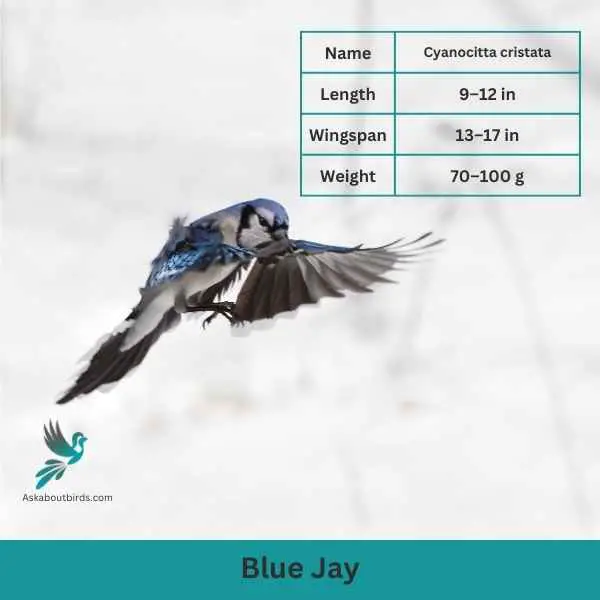
| Feature | Measurement |
|---|---|
| Scientific Name | Cyanocitta cristata |
| Length | 9–12 in |
| Wingspan | 13–17 in |
| Weight | 70–100 g |
The Blue Jay is a vibrant and easily recognized bird, known for its intelligence, distinctive calls, and bold behavior, commonly found throughout the eastern and central United States.
Appearance: The Blue Jay sports a striking blue upper body with white and black markings. Its face has a pronounced white patch with a black necklace that runs across the throat and around the head. The bird also features a pronounced blue crest, which can be raised or lowered, and its wings and tail are brightly colored with black bars and white tips.
Diet: Blue Jays are omnivores. Their diet consists primarily of seeds, nuts, especially acorns, fruits, and small insects. They’ve also been known to eat eggs or nestlings of other birds occasionally. Blue Jays often store food items in caches to eat later.
Reproduction: Blue Jays are monogamous birds that form long-lasting pair bonds. They typically build their nests in trees or large shrubs, constructing them from twigs, grass, and sometimes using mud as a binder. The female lays a clutch of 3 to 6 eggs, which are pale blue or sometimes white with brown speckles.
Blue Grosbeak
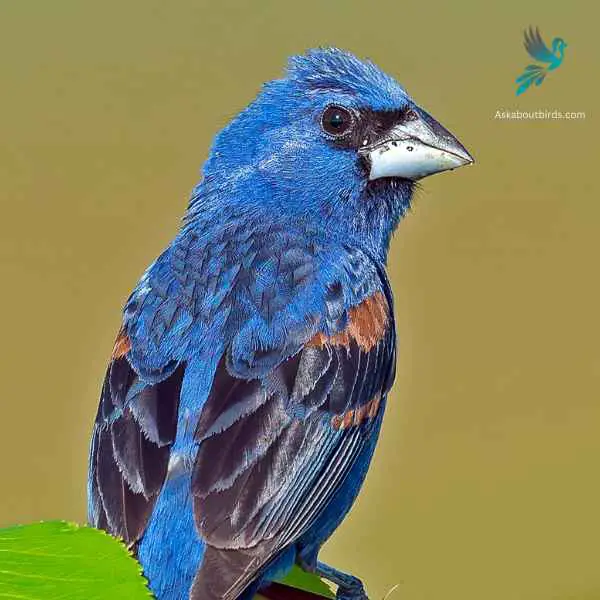

| Feature | Measurement |
|---|---|
| Scientific Name | Passerina caerulea |
| Length | 5.5 to 7.5 in |
| Wingspan | 10 to 11 in |
| Weight | 26 to 31.5 g |
The Blue Grosbeak is a medium-sized songbird found in North and Central America. The male Blue Grosbeak displays stunning plumage with deep blue feathers on its body and head, while the female has more subdued brownish tones. Both sexes have a thick, conical bill, which gives them their name “grosbeak,” meaning large beak.
These birds prefer open habitats such as grasslands, brushy areas, and woodland edges. Blue Grosbeaks are known for their melodious songs, which consist of a series of rich and varied notes. They primarily feed on seeds and insects, using their strong beaks to crack open seeds and forage on the ground or in low vegetation.
Blue-headed Vireo
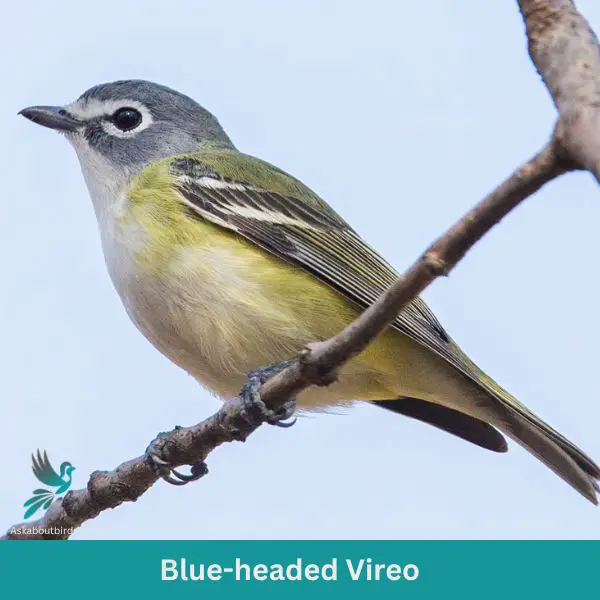
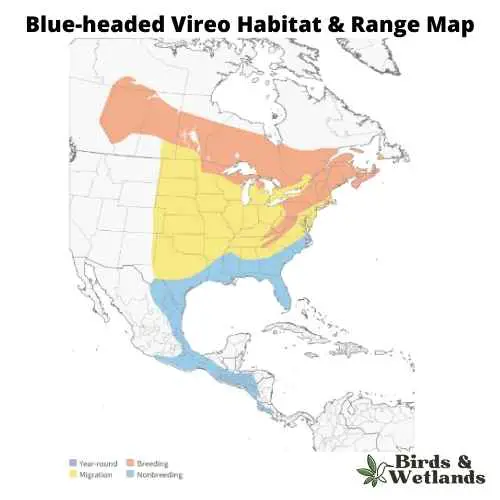
| Trait | Blue-headed Vireo |
|---|---|
| Scientific Name | Vireo solitarius |
| Length | 5-5.5 inches |
| Wingspan | 7.9-9.8 inches |
| Weight | 0.4-0.6 ounces |
The Blue-headed Vireo is a songbird recognized for its sharp and clear song as well as its distinct coloration.
Appearance: It has a blue-gray head and nape, contrasting sharply with its white throat and belly. A white eye ring combined with two white wing bars and yellowish flanks further accentuate its appearance.
Diet: The Blue-headed Vireo feeds mainly on insects and spiders. It often forages in the forest canopy, picking prey off leaves and twigs.
Reproduction: The female constructs a cup-shaped nest made of twigs, bark, and spiderwebs, often placed in the fork of a tree branch. Typically, she lays a clutch of 3-5 eggs. Both parents share the responsibility of incubating the eggs and feeding the chicks.
Belted Kingfisher

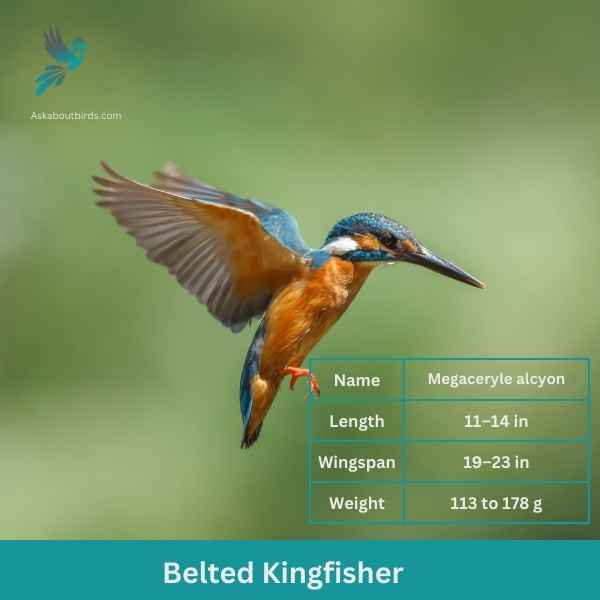
| Feature | Measurement |
|---|---|
| Scientific Name | Megaceryle alcyon |
| Length | 11–14 in |
| Wingspan | 19–23 in |
| Weight | 113 to 178 g |
The Belted Kingfisher is a distinctive and easily recognizable bird, frequently observed near water bodies, where it can be seen diving headfirst to catch prey.
Appearance: Sporting a prominent crest, the Belted Kingfisher has a slate blue-gray upper body and white underparts. Males possess a single blue band across their white chests, while females have an additional rufous band, making them one of the few bird species where females are more brightly colored than males. Their bill is long, sharp, and dagger-like.
Diet: As expert fishers, Belted Kingfishers mainly prey on small fish, but they’ll also consume crustaceans, insects, and amphibians. They’re known for their hunting tactic of hovering over water, spotting their prey, and then diving swiftly to snatch it.
Reproduction: Belted Kingfishers nest in burrows which they excavate in sandy or earthen banks, usually adjacent to water. The tunnel can be anywhere from 3 to 6 feet long, ending in a chamber. Within this chamber, the female lays a clutch of 5 to 8 white eggs.
Tree Swallow
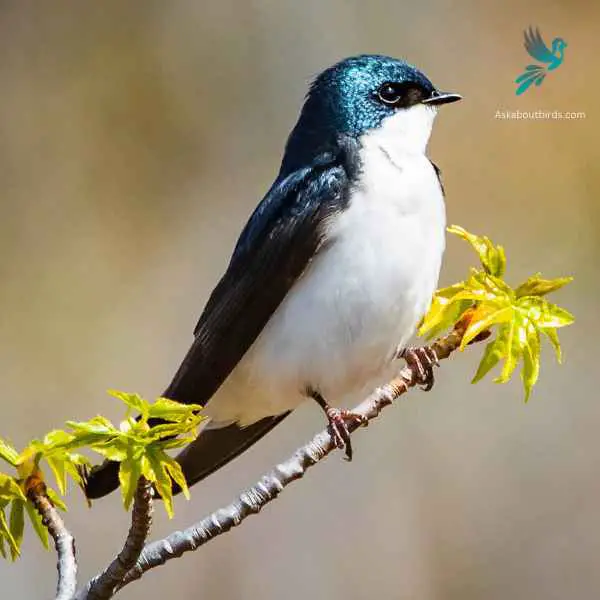
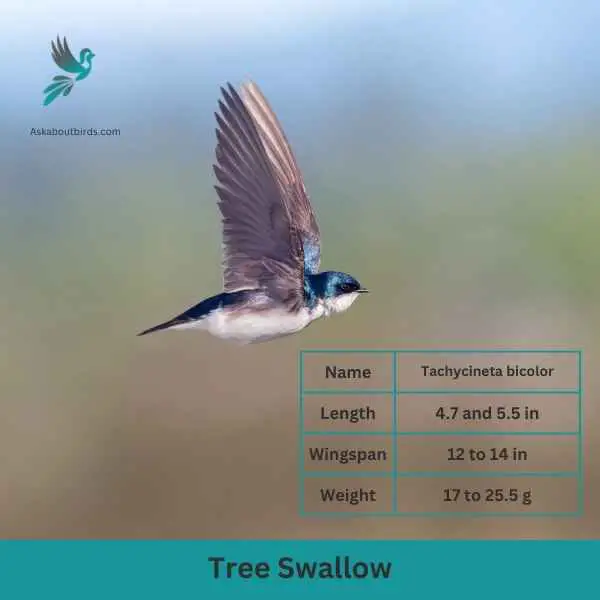
| Feature | Measurement |
|---|---|
| Scientific Name | Tachycineta bicolor |
| Length | 4.7 and 5.5 in |
| Wingspan | 12 to 14 in |
| Weight | 17 to 25.5 g |
The Tree Swallow is a graceful and agile bird, best recognized for its iridescent blue-green upperparts and sweeping flight patterns over open fields and water.
Appearance: The Tree Swallow is sleek with a streamlined body. The upperparts shine with a blue-green iridescence while the underparts are white. They possess long, pointed wings and a slightly forked tail, aiding in their agile flight.
Diet: Tree Swallows primarily feed on flying insects, skillfully catching them mid-air. During colder months when insects are scarce, they can switch to a diet of berries, particularly those of the bayberry, which other birds might find hard to digest.
Reproduction: Tree Swallows are cavity-nesters, typically choosing natural holes in trees or using bird boxes. They line their nests with feathers, creating a soft environment for the eggs. The female will lay a clutch of 4 to 7 white eggs.
Barn Swallow


| Feature | Measurement |
|---|---|
| Scientific Name | Hirundo rustica |
| Length | 6.5–7.5 in |
| Wingspan | 12.5–13.5 in |
| Weight | 16–22 g |
The Barn Swallow is a sleek, agile bird renowned for its graceful flight patterns and iconic forked tail, often seen darting over fields and water bodies in search of flying insects.
Appearance: Barn Swallows have deep blue, almost iridescent, upperparts and a rufous to tawny underbelly. Their distinctively forked tail and long wings give them a streamlined look. Both males and females have a similar appearance, though males often exhibit slightly brighter colors and a deeper fork in the tail.
Diet: Barn Swallows feed primarily on flying insects, which they catch in mid-air during their agile and acrobatic flights. Their diet includes flies, beetles, moths, and other small flying insects.
Reproduction: Barn Swallows are known for building their mud nests on man-made structures, particularly barns, bridges, and eaves. The nest is cup-shaped and made from mud pellets, often lined with feathers. The female lays a clutch of 4 to 6 eggs.
Common Grackle
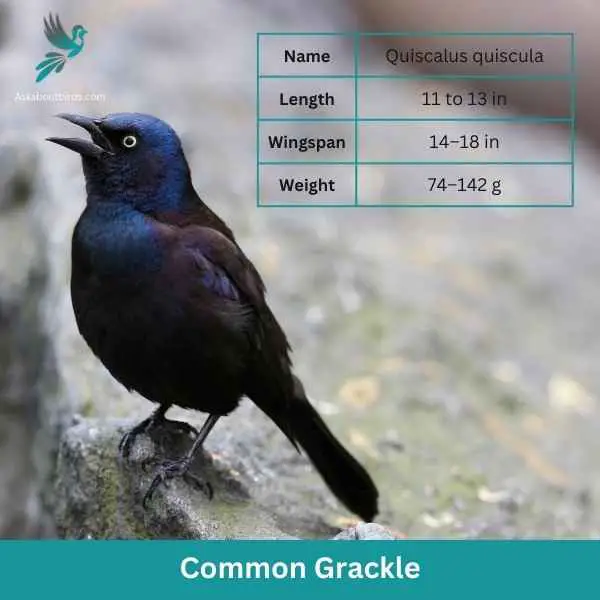

| Feature | Measurement |
|---|---|
| Scientific Name | Quiscalus quiscula |
| Length | 11 to 13 in |
| Wingspan | 14–18 in |
| Weight | 74–142 g |
The Common Grackle is a conspicuous bird found across much of North America, recognized for its glossy-black plumage, long tail, and piercing yellow eyes. Its vocalizations are varied and include a range of harsh, grating calls.
Appearance: The Common Grackle has a sleek black body with a glossy-iridescent sheen that can appear purple, green, or blue in certain lights. Its tail is long and keel-shaped. While both males and females have similar coloration, males are noticeably larger and shinier than females.
Diet: Common Grackles are omnivores. They primarily consume seeds, berries, and insects. However, they are also known to eat small fish, amphibians, and other birds’ eggs, especially when foraging on the ground or in shallow water.
Reproduction: Common Grackles breed in open and semi-open areas. The female typically selects the nest site and constructs a bulky nest made of grasses, twigs, and other plant materials, often in shrubs or trees. She lays a clutch of about 1 to 7 eggs, which are pale blue and spotted with brown.
Where to Spot New Hampshire ’s Blue Birds
New Hampshire, with its varied landscapes and habitats, is a haven for bird watchers. Here are some of the top locations in the state known for their incredible diversity of bird species, including the mesmerizing blue birds:
- Pisgah State Park: Covering over 13,000 acres, this is the largest state park in New Hampshire. It is a prime location for birdwatching with its extensive trail system, wetlands, and mixed hardwood forests.
- Odiorne Point State Park: Located on the seacoast, this park offers a variety of habitats including salt marshes, rocky shores, and woodlands, making it a hotspot for bird diversity.
- Pawtuckaway State Park: A mix of marshes, bogs, and forests make this state park a great destination for spotting a variety of bird species.
- Great Bay National Wildlife Refuge: This refuge is one of the best spots in the state for bird watching. The mix of upland hardwood forest, wetlands, and open water provide habitat for a wide variety of birds.
- Karin Prescott Nature Preserve: This 400-acre preserve features a mix of pine and hardwood forests, as well as wetlands, making it a prime location for bird watching throughout the year.
| Neighboring States | Best Spots for Blue Birds |
|---|---|
| Vermont’s Blue Birds | 1. Dead Creek Wildlife Management Area 2. Missisquoi National Wildlife Refuge 3. Green Mountain National Forest |
| Maine’s Blue Birds | 1. Acadia National Park 2. Baxter State Park 3. Scarborough Marsh |
| Massachusetts’ Blue Birds | 1. Plum Island 2. Quabbin Reservoir 3. Parker River National Wildlife Refuge |
FAQs on Blue Bird Species Found in New Hampshire
What are the best practices for feeding bluebirds?
Feeding bluebirds requires some special considerations compared to feeding other wild birds. Bluebirds primarily eat insects, but they also enjoy fruit and berries. Live mealworms are a bluebird’s special favorite and can be provided in a shallow dish or a platform feeder. You can also offer sunflower seeds, peanut butter mixes, and raisins soaked in hot water. It’s important to note that while bluebirds enjoy these treats, it’s essential to provide them with a natural habitat with plenty of insects. Scattered trees and thick shrubbery can help attract more bluebirds and other insects, which are their primary food source. Additionally, ensure that you regularly clean the feeders and provide fresh water.
What can I feed the bluebirds in winter?
In winter, natural food sources for bluebirds like insects and berries can be scarce. To help them survive, you can provide them with a variety of foods in their nesting sites. Live mealworms are a bluebird’s special favorite and a good source of protein. You can also offer peanut butter mixes, whole peanuts, sunflower seeds, raisins soaked in hot water, and suet. When feeding bluebirds, make sure to have a heated bird feeder or a platform bird feeder, to keep the food from freezing.
How can I attract Eastern Bluebirds to my nest boxes?
To attract Eastern Bluebirds to your nest boxes, it is essential to place them in the right habitat. Eastern Bluebirds prefer open areas with scattered trees, such as golf courses, large yards, and pastures. Make sure the entrance hole is about 1.5 inches in diameter to keep out larger birds and place the nest box on a pole with a predator guard to keep out snakes and raccoons. Also, regularly monitor the nest boxes to remove any nests built by invasive species like house sparrows.
What is the breeding range of the Purple Martin?
The Purple Martin has a wide breeding range across North America. According to range maps from the Cornell Lab of Ornithology and New Hampshire Audubon, they breed throughout the eastern United States, reaching as far north as southern Canada and as far west as the Rocky Mountains. Some populations of birds are also found along the west coast of the United States. These blue beauties migrate south to Central and South America.

